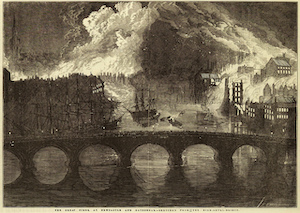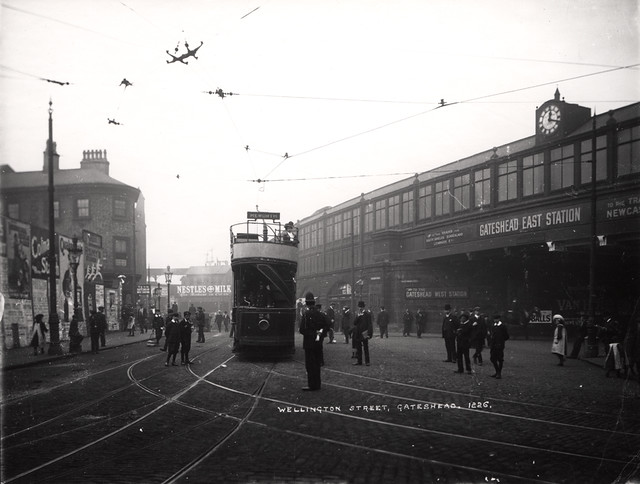Topics > Tyne and Wear > Gateshead > Gateshead and District, 1855
Gateshead and District, 1855
Extract from: History, Topography, and Directory of Northumberland...Whellan, William, & Co, 1855.
GATESHEAD AND DISTRICT
GATESHEAD is a parish and a corporate and parliamentary borough, situated in the eastern division of Chester Ward, county of Durham, about 14 miles North of the city of Durham, and 222 N.W. of London. The parish contains an area of 3,255 acres; its population in 1801, was 8,597; in 1811, 8,782; in 1821, 11,767; in 1831, 15,177; in 1841, it had increased to 19,506: and in 1851 it had attained to 25,569 souls, of whom 12,863 were females and 12,705 males. There were at the same period 3,528 inhabited houses, 73 uninhabited, and 68 in course of erection. The extensive and elevated tract of ground called Gateshead Fell, was formerly part of the parish of Gateshead, under which all the returns are included, but although it was made a distinct parish and rectory in 1808, it was provided by the act of parliament which made the division, "that nothing in this act contained shall alter or affect the manor of Gateshead, or the division of the said parish into townships for separate districts, for the maintenance of the poor, or for any other civil purpose whatever, but that the said manor and parish of Gateshead shall, as to those purposes, remain in all respects the same as if this act had not passed." Here are the celebrated "Newcastle Grindstone" quarries, and several collieries.
THE TOWN of Gateshead is situated on the south bank of the Tyne, opposite to Newcastle, with which it is connected by means of the Tyne Bridge, and the beautiful and unique High Level Bridge. Gateshead is more formidable in respect to steepness than its opposite neighbour, Newcastle. The ascent from the river's bank is no less than five hundred feet in two miles, and some of the streets leading from the old railway station to the bridge, are such as horses and drivers regard with an anxious eye. From this station, or from any contiguous spot, the view over the two towns is very striking; the river; the shipping, the coal-keels, the factories, the glass-works, the pottery-works, the lofty chimneys, the steeples, the new railway bridge - that grandest of features in the town all combine to form a scene of great activity and interest. Gateshead consists of only one good and wide street on the high road to the north. The several narrow streets and lanes which compose the remainder; branch off on each side of the principal or High-street. Bottle-bank is a street descending precipitately from the High-street towards the bridge, but since the formation of Church-street, which passes down the side of the hill in a curved course, carriages avoid this steep descent. Although many of the old houses have been re-built or modernised, and several streets formed in course of the present century, there is little appearance of wealth, or of houses belonging to the richer class. The town is densely peopled with families of artisans and pitmen, while the master manufacturers, and proprietors of coal-pits within the borough, reside in Newcastle, or in the vicinity of High and Low Fell, which are hamlets in the southern and rural districts of the palish. Many of the close alleys and fever-dens of Gateshead have been swept away by the late fire and explosion, and it is to be hoped that their sites will be occupied by spacious thoroughfares and improved dwellings.
The derivation of the name Gateshead, has long been a matter of doubt and dispute with antiquaries. Camden and others supposed that the Gabrosentum of the Notitia was here, and Stukely, after finding the place called Ad Caprm Caput by Bede, and seeing a goat's head used as a sign, found that Gabrosentum in British signified goat's head. Simeon of Durham, speaking of the murder of Bishop Walcher, says it happened at Ad Caprm Caput, which he also terms Gateshead. Some think that because a branch of the Wailing-street ended here, it was called Gateshead, or End ; gate in ancient as in modem times, signifying a street or road.
From the proximity of this town to Newcastle, its history is closely intewoven with the annals of that place, hence the most remarkable events which have transpired here, have been described in the historical notice of Newcastle. With regard to the foundation of the town we possess no authentic information, and to enter into the various conjectures which have been formed by antiquarians, is foreign to our purpose. That it was a town prior to the year 1164, we have ample evidence in the charter granted by Bishop Pudsey, to the inhabitants of Gateshead, in which, under certain restrictions, they are allowed the liberty of his forest there. By the same charter the bishop granted to the inhabitants, equal privileges to those enjoyed by the people of Newcastle, and he also granted them free passage with their goods through his county palatine, clear of all dues and exactions.
The most material circumstance for which we find Gateshead noted in ancient history, is touching the catastrophe related of Bishop Walcher, when, on the 14th of May, 1080, the church was reduced to ashes. The earldom of Northumberland had been given, after the condemnation of Waltheof, to Walcher, a native of Lorraine, who had been lately raised to the see of Durham. The bishop was of a mild. and easy disposition, his humanity revolted from the idea of oppressing the inhabitants himself, but his indolence prevented him from seeing or restraining the oppressions of his officers. Liulf, a noble Englishman, had ventured to accuse them before the prelate, and in the course of a few days he was slain. Walcher, to allay the ferment, declared his innocence of the homicide, compelled the murderers to offer the legal compensation, and engaged to act as mediator between them and the relations of Liulf. Both parties met by agreement at Gateshead, but the bishop perceiving indications of violence among the natives, retired into the church, which was immediately set on fire by the infuriated people. He compelled, the murderers to go out, who were immediately slain. At length, unable to bear the violence of the flames, he wrapped his mantle round his head, and appeared at the door. A voice immediately exclaimed; "Good rede, short rede; slay ye the bishop!" and he fell pierced with a number of wounds. His death was not sufficient to appease the revenge, for then mangled and insulted his body, which was found naked on the spot by the monks of Jarrow, who conveyed it by water, first to their own monastery, and subsequently to Durham, where it, was privately buried in the cathedral.
ln the reign of Edward VI. Gateshead, was separated from the possessions of the Bishop of Durham, and annexed to Newcastle, but was subsequently restored to its original proprietor. Bishop. Skirlaw, in 1553, granted to the corporation of Newcastle a tract of land lying to the east of Gateshead, and known by the name of the "Salt Meadows," and in a short time afterward, Bishop Barnes let to Queen Elizabeth, for a term of 99 years, the manors of Gateshead and Whickham, which lease was subsequently transferred to the corporation of Newcastle. On its reversion to the see of Durham in 1716, the park and manor of Gateshead were granted on a 21 year's lease, renewable every year, at the annual rent of £235. 11s. 4d. to W. Coatsworth, Esq. from whom the lease has descended to Cuthbert Ellison, Esq. of Hebbum Hall, the present proprietor.
The freehold property denominated the " Borough Lands," which are vested in the "borough holders" and freemen, cannot be traced to its original possessors. We find that in 1557, the burgesses were in possession of Windmill Hill, Longflatt, and Stoneflatt, and that shortly afterwards they litigated their common right in Redheugh and Harelaw, with the Whites of Redheugh. There is a decree of Queen Elizabeth, which recognises the right of pasture in the "Town Fields," and we find cows pastured there in 1607. By an act of parliament obtained in 1814, power was granted to enclose and divide certain portions of the borough-lands; or town-fields. The quantity divided according to the proportion of borough tenure and common right, amounted to 157 acres. A certain portion of the land, was reserved under the authority of the act; it contained about ten acres, and with the buildings upon it, constituted the property of the borough-holders, and freemen, whose number at present, is very limited.
Also in this Directory (Whellan, 1855) for Gateshead:
- Description of Gateshead
- Churches of Gateshead
- Schools in Gateshead
- Public & Civil Buildings etc in Gateshead
- Manufacturers & Trade
- Borough and Corporation of Gateshead
- Charities
- Gateshead District
- Post Office
- Gateshead and District Directory

Co-Curate Page
Great Fire of Gateshead and Newcastle, 1854
- Overview History "A dreadful fire took place at Gateshead on the morning of the 6th October 1854. It broke out on tbe premises of a worsted factory in the vicinity …










